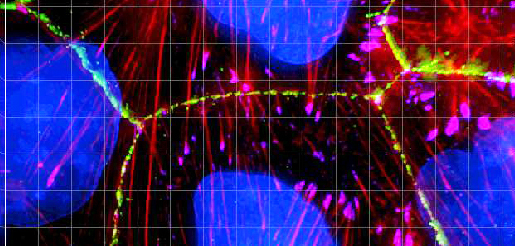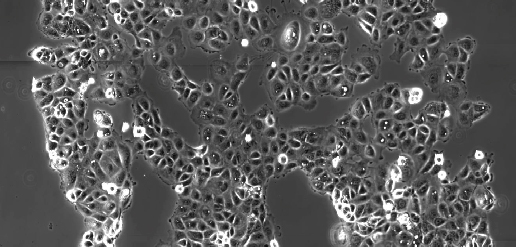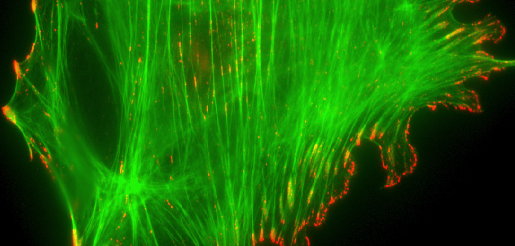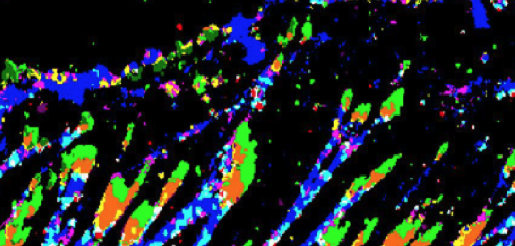
Caco-2 cells labeled for tight junction molecule cingulin (green), actin (red), vinculin (pink) and DNA (blue).

Epithelial cells growing on a patterned adhesive surface with the shape of the Weizmann Institute tree.

Desmosomes in mouse tongue epithelium (by transmission electron microscope).

Porcine aortic endothelial cell, double-labeled for actin (green) and phospho-tyrosine (red).

“Molecular composition map” of focal adhesions and stress fibers.

Myeloma cancer cell responding to shear flow (by scanning electron microscope).
You are here
Screening Projects ››A cell-based screening system for discovery of novel proteasome inhibitors
Background
Normal cellular functioning requires processing of proteins regulating cell cycle, growth, and apoptosis. The ubiquitin-proteasome pathway (UBP) modulates intracellular protein degradation. Specifically, the 26S proteasome is a multienzyme protease that degrades misfolded or redundant proteins; conversely, blockade of the proteasomal degradation pathways results in accumulation of unwanted proteins and cell death. Because cancer cells are more highly proliferative than normal cells, their rate of protein translation and degradation is also higher making them more sensitive to proteasome inhibitors. This notion led to the development of proteasome inhibitors as therapeutics in cancer. The FDA recently approved the first proteasome inhibitor bortezomib (Velcade) for the treatment of newly diagnosed and relapsed/refractory multiple myeloma. Still, there is a growing need for novel inhibitory molecules, due to the emergence of drug resistant cells.
Rationale
Most of the current assays for proteasome inhibitors are based on cell free assays, which may fail to predict inhibitory activity in live cells. In our lab we use an imagebased screening approach, which utilizes an H1299 reporter cell line, stably expressing a fluorescent “Proteosome Inhibition Reporter”(PIR) protein. This approach is highly sensitive and compatible with high throughput microscopy as described in Lavelin I. et al. (2009).
Methods
In this assay we use a YFP-tagged proteasome inhibitor Reporter protein. The protein is a full length mutant p53.The PIR protein is expressed in an H1299 non-small cell lung carcinoma cell line. The screen is based on the finding that under normal culture conditions the fluorescent reporter is localized in the cytoplasm and upon inhibition of proteasomal activity, the fluorescent reporter molecule translocates from the cytoplasm to the nucleus. The Hermes cell imaging system (Idea Bio-Medical) is used for this screen. Twenty fields are acquired from every well using a 40x air objective. Scoring of nuclear translocation of the fluorescent PIR protein is carried out by a software called nuclear translocation developed by Idea Bio-Medical. We are in the process of screening libraries in order to discover unknown proteasome inhibitors. The screening performed Lavelin I. et al. (2009) of the Diversity set of NIH/NCI chemical library identified four compounds with proteasome inhibitory activity, three of which are novel. Another library screened is the Analyticon discovery library which contains compounds purified from plants and bacteria, with a high novelty rate. This screen yielded several hits which are currently being tested.
Contact person: Yael Sagi
- Scientific Activities
- Publications
- Group Members
- Collaborations
- Screening Projects
- A cell-based screening system for discovery of novel proteasome inhibitors
- Fibroblast polarization is a matrix-rigidity-dependent process controlled by focal adhesion mechanosensing
- Identification of Novel Pro-Migratory, Cancer-Associated Genes Using Quantitative, Microscopy-Based Screening
- Multiparametric analysis of focal adhesion formation by RNAi-mediated gene knockdown
- Screening for genes involved in collective cell migration
- Software
- Galleries
- Research
